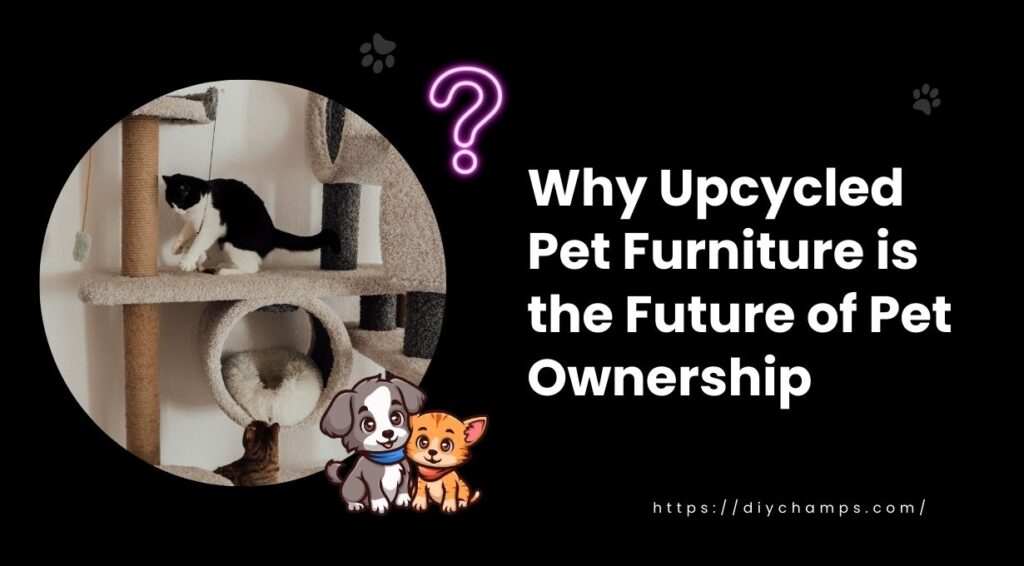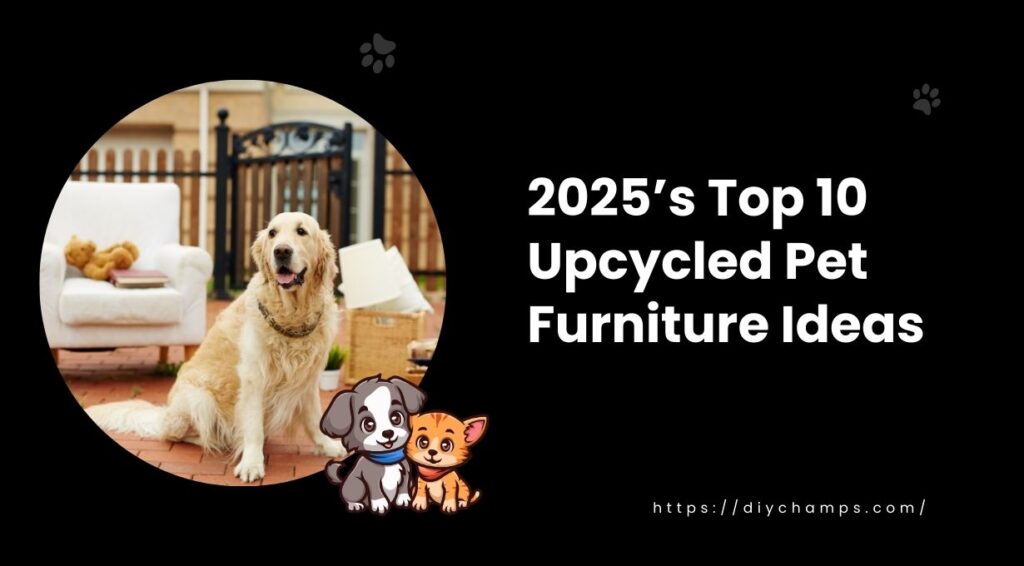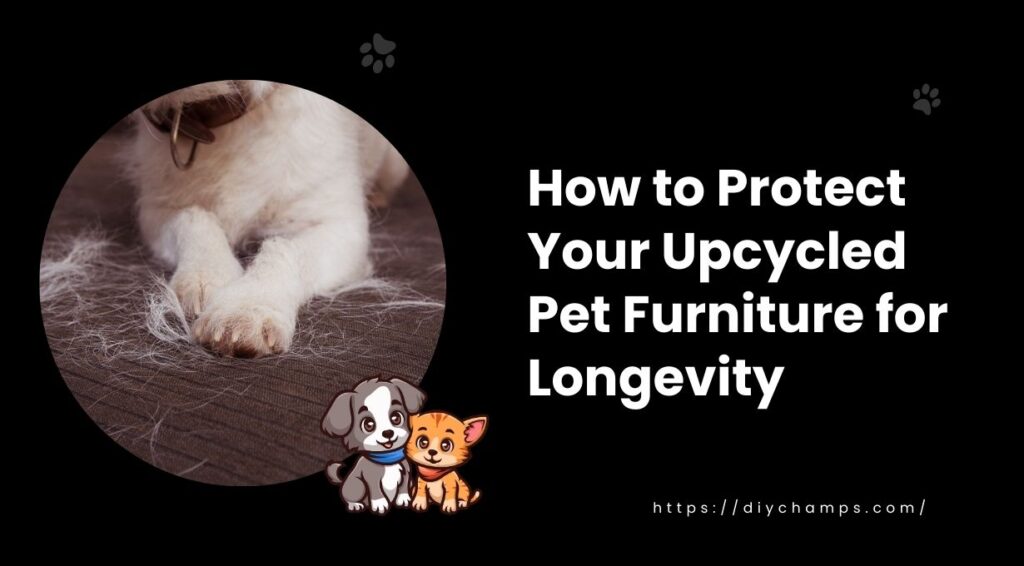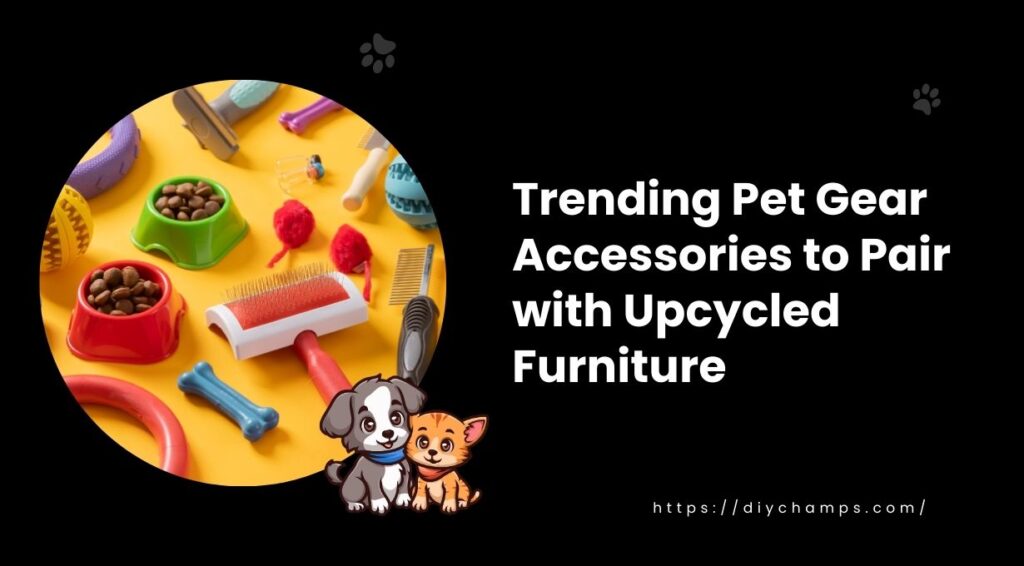If your furry friend has ever claimed your favorite couch as their personal throne or turned your coffee table into a chew toy, you’re not alone. But what if you could protect your furniture and pamper your pet-all while saving money and the planet? Enter upcycled pet furniture, the 2025 trend taking over homes by storm. A whopping 63% of pet owners are already repurposing old dressers, suitcases, and even skateboards into stylish, eco-friendly pet beds, climbing towers, and ramps. Gone are the days of bland, overpriced pet gear.
Today’s DIY projects blend creativity, sustainability, and practicality, giving pets the cozy spots they crave and owners the peace of mind they deserve. Ready to join the movement? Let’s dive into 10 genius upcycled ideas that’ll transform your trash into pet-friendly treasure.
Why Upcycled Pet Furniture is the Future of Pet Ownership

1. The Rise of Eco-Conscious Pet Parents
Modern pet owners are increasingly aware of their environmental footprint. With landfills overflowing and plastic pollution threatening ecosystems, sustainable pet products have become a priority. Upcycling-breathing new life into old materials aligns perfectly with this ethos. Instead of buying new, pet parents are repurposing furniture, textiles, and household items, reducing waste while creating unique, toxin-free spaces for their pets.
2. The DIY Boom: Creativity Meets Practicality
The pandemic-fueled DIY craze never truly faded. In fact, it evolved into a sustainable revolution. A staggering 63% of pet owners now craft their own pet furniture, according to a 2024 Pet Sustainability Survey. Why? DIY projects cut costs (no $300 cat trees here!), allow customization for pet-specific needs, and offer a creative outlet. Social media platforms like Instagram and TikTok are flooded with #UpcycledPetHacks, proving that sustainability can be stylish and shareable.
3. Healthier Pets, Healthier Planet
Conventional pet furniture often contains synthetic materials, chemical glues, or non-recyclable plastics. Upcycled alternatives, however, let owners control the materials—think organic fabrics, untreated wood, or non-toxic paints. Plus, reusing items like old sweaters or wooden pallets keeps them out of landfills, shrinking your pet’s carbon “pawprint.”
2025’s Top 10 Upcycled Pet Furniture Ideas

1. Antique Wardrobe Cat Condo with Hidden Litter Box
Why It’s Genius:
Antique wardrobes aren’t just for Narnia adventures anymore. By converting a vintage wardrobe into a cat condo, you create a multi-functional space that doubles as odor-resistant pet furniture. Remove the bottom drawer to install a hidden litter box (lined with charcoal filters or baking soda to neutralize smells) and repurpose upper shelves into cozy lounging nooks.
DIY Steps:
- Sand and seal the interior with pet-safe, non-toxic paint.
- Cut a discreet entry hole in one side for easy access.
- Add removable fabric curtains or a sliding door to conceal the litter area.
Sustainability Perk: Rescuing an old wardrobe from landfills reduces wood waste while providing cats with a private, odor-controlled bathroom retreat.
2. Recycled Tire Dog Bed with Waterproof Inner Liner
Why It’s Genius:
Old tires are notoriously difficult to recycle, but their sturdy rubber construction makes them ideal for chew-proof pet furniture. Line the interior with a waterproof silicone or PVC liner (upcycled from shower curtains or pond liners) to create a bed that’s both weather-resistant and spill-proof.
DIY Steps:
- Clean the tire thoroughly and sand rough edges.
- Add a cushion made from memory foam and upcycled fabric.
- Paint the exterior with pet-safe, vibrant colors for a playful touch.
Durability Factor: Tires are virtually indestructible, making this bed perfect for power chewers or outdoor use.
3. Bookshelf-to-Pet Feeding Station with Spill Guard
Why It’s Genius:
Transform a narrow bookshelf into an elevated feeding station that promotes better posture for pets. Add custom-cut acrylic or wooden spill guards around stainless steel bowls to prevent messy kibble avalanches.
DIY Steps:
- Cut circular holes in a shelf to snugly fit bowls.
- Attach removable spill guards using Velcro for easy cleaning.
- Paint the shelf with wipeable, non-toxic epoxy for stain resistance.
Health Bonus: Elevated feeders reduce neck strain, especially for older pets or breeds prone to bloat.
4. Upcycled Baby Crib Pet Playpen (Ideal for Multi-Pet Homes)
Why It’s Genius:
Old baby cribs are a goldmine for multi-pet furniture. Remove one side panel to create an open playpen, and repurpose the mattress into a cushioned base. Add hanging toys, scratching posts, or hammocks to keep cats, dogs, or small pets entertained.
DIY Steps:
- Sand and paint the crib with pet-safe finishes.
- Use zip ties to secure sisal rope to rails for scratching.
- Layer the base with machine-washable blankets.
Space-Saving Tip: Foldable cribs can be stored easily, making them perfect for apartments.
5. Vintage Suitcase Pet Carrier with Ventilation Cutouts
Why It’s Genius:
Hard-shell suitcases offer durability and retro charm. Convert one into a portable pet carrier by cutting ventilation holes along the sides and lining the interior with breathable mesh fabric. Add a removable fleece pad for comfort.
DIY Steps:
- Use a hole saw to create air vents and reinforce edges with sandpaper.
- Attach a secure latch or buckle to keep the lid closed during transit.
- Personalize with stickers or stencils for a quirky touch.
Travel-Ready: Lightweight and airline-compliant dimensions make this ideal for stress-free vet visits or weekend getaways.
6. Repurposed Wine Barrel Cat Scratching Post & Lounge
Why It’s Genius:
Wine barrels, often discarded after aging their last vintage, are naturally sturdy and visually striking. Split a barrel horizontally to create a half-moon lounger, and wrap the curved exterior with sisal rope for scratching.
DIY Steps:
- Sand the interior to remove splinters and seal with beeswax.
- Secure sisal rope using eco-friendly adhesive.
- Add a cushion filled with recycled foam for napping.
Aesthetic Appeal: The rustic wood grain complements farmhouse or industrial décor, proving sustainability can be chic.
7. DIY PVC Pipe Pet Stroller for Senior Dogs
Why It’s Genius:
Older dogs with mobility issues often struggle on long walks. Upcycle PVC pipes (leftover from plumbing projects) into a lightweight pet stroller with bicycle wheels and a removable padded bed.
DIY Steps:
- Construct a rectangular frame using PVC connectors.
- Attach wheels to the base and a handlebar to the top.
- Drape the frame with breathable mesh fabric for shade.
Comfort Focus: Add a memory foam insert to cushion arthritic joints during strolls.
8. Old Ladder Dog Ramp with Non-Slip Treads
Why It’s Genius:
Wooden ladders can be repurposed into ramps for senior pets or small breeds struggling to climb into cars or onto furniture. Add non-slip rubber treads (cut from old yoga mats) for traction.
DIY Steps:
- Sand the ladder and trim it to your desired length.
- Secure treads with waterproof adhesive.
- Attach hinges to fold the ramp for easy storage.
Safety First: Test weight capacity with books or weights before letting pets use it.
9. Upcycled Dresser Dog Crate with Removable Washable Covers
Why It’s Genius:
Turn a secondhand dresser into a discreet furniture-style dog crate. Remove the drawers, reinforce the structure, and add a removable, machine-washable fabric cover to the interior.
DIY Steps:
- Cut an entryway into one side of the dresser.
- Line the interior with waterproof laminate for easy cleaning.
- Use magnetic clasps to secure a fabric curtain over the opening.
Blend-In Bonus: The dresser doubles as a side table or TV stand, ideal for small spaces.
10. Pallet Wood Outdoor Pet Sofa with Weatherproof Finish
Why It’s Genius:
Wooden pallets are a DIY staple, but their potential shines in outdoor projects. Build a raised sofa with pallet slats and treat it with a weatherproof finish (like linseed oil or eco-friendly sealant) to withstand rain and sun.
DIY Steps:
- Disassemble pallets and sand each slat.
- Assemble a bench-style frame and add a cushion filled with quick-dry foam.
- Top with outdoor-grade fabric or a waterproof throw.
Durability Hack: Elevate the sofa with bricks to prevent moisture damage from damp ground.
How to Protect Your Upcycled Pet Furniture for Longevity

Creating upcycled pet furniture is a labor of love and a smart way to reduce waste. But let’s face it: pets can be messy, rowdy, and downright destructive. To ensure your DIY masterpieces withstand scratches, spills, and chew sessions, you’ll need a game plan for protection. Here’s how to keep your upcycled pet furniture looking fresh and functional for years, using simple, affordable strategies.
1. Invest in Removable, Washable Pet Furniture Covers
Why It Matters:
Pets shed, drool, and occasionally have accidents. Fabric surfaces-like beds, sofas, or crate liners—bear the brunt of this wear and tear. Removable, machine-washable covers act as a first line of defense, shielding your furniture from stains, odors, and fur buildup.
Pro Tips:
- Choose the Right Fabric: Opt for durable, tightly woven materials like canvas, denim, or outdoor-grade polyester. These resist claws and are less likely to trap pet hair.
- Double Up: Layer waterproof liners (like PUL fabric or repurposed shower curtains) beneath decorative covers for added protection against spills.
- Custom Fit: Sew Velcro straps or elastic edges to keep covers snug. For non-sewers, stretchy fitted sheets or old sweater sleeves can work in a pinch.
Example: A vintage suitcase bed lined with a washable fleece cover can be stripped and cleaned weekly, preventing odors without damaging the original structure.
2. Seal Surfaces with Pet-Safe Waterproof Sprays
Why It Matters:
Waterproofing isn’t just for outdoor gear! Applying a protective sealant to wooden, fabric, or wicker surfaces guards against urine, water spills, and muddy paws. It also prevents warping, mold, and bacterial growth.
Pro Tips:
- Non-Toxic Formulas Only: Use sprays labeled “pet-safe” and free of volatile organic compounds (VOCs). Brands like Eco Advance or AFM Safecoat are reliable choices.
- Focus on High-Risk Areas: Pay extra attention to corners, seams, and bases where moisture tends to pool.
- Reapply Seasonally: Humidity, temperature changes, and cleaning can wear down coatings. Refresh every 3–6 months for optimal results.
DIY Hack: For wooden furniture (like pallet sofas or ladder ramps), mix equal parts beeswax and coconut oil as a natural, water-repellent polish.
3. Use Chew-Resistant Materials in High-Impact Zones
Why It Matters:
Dogs, rabbits, and even bored cats love to gnaw. Reinforce legs, edges, and corners with materials that can withstand teeth and claws without sacrificing aesthetics.
Pro Tips:
- Sisal Rope & Metal Accents: Wrap furniture legs in sisal (a natural fiber cats love to scratch) or secure chew-proof metal plates to corners.
- Hardwoods Over Softwoods: If rebuilding parts of your furniture, choose dense woods like oak or maple, which are tougher to splinter.
- Deterrent Sprays: Apply bitter apple or citrus-based sprays to non-fabric areas. Pets hate the taste, and it’s harmless to furniture.
Case Study: A recycled tire dog bed becomes virtually indestructible when lined with a chew-resistant PVC inner liner and topped with a replaceable cushion.
4. Design with Maintenance in Mind
Why It Matters:
The easier your furniture is to clean, the longer it’ll last. Prioritize designs with smooth surfaces, removable parts, and minimal crevices where dirt can hide.
Pro Tips:
- Avoid Carpeted Surfaces: Carpet traps hair and odors. Swap it out for wipeable materials like vinyl, laminate, or tightly woven fabric.
- Modular Components: Build scratching posts, cushions, or spill guards as separate, replaceable pieces. If one part wears out, you won’t need to rebuild the entire structure.
- Elevate Outdoor Furniture: Raise pallet wood sofas or dog houses a few inches off the ground with bricks or PVC legs to prevent rot from damp soil.
5. Regular Inspections & Quick Repairs
Why It Matters:
Small issues like loose screws, frayed ropes, or chipped sealant can snowball into major damage if ignored. A monthly “check-up” keeps your furniture safe and functional.
Pro Tips:
- Tighten & Glue: Secure wobbly joints with wood glue or L-brackets. Replace rusty nails with stainless steel screws.
- Patch & Sand: Fill scratches in wooden surfaces with food-grade epoxy, then sand smooth to prevent splinters.
- Rotate Cushions: Flip and rotate beds or pads regularly to distribute wear evenly.
Trending Pet Gear Accessories to Pair with Upcycled Furniture

Upcycled pet furniture isn’t just a standalone trend-it’s part of a broader movement toward thoughtful, eco-conscious pet ownership. To maximize the functionality and style of your DIY creations, pairing them with 2025’s hottest pet gear accessories is key. From smart tech that monitors your pet’s well-being to mobility aids that enhance comfort, these innovations blend seamlessly with upcycled designs. Let’s explore how to elevate your pet’s space with accessories that are as practical as they are planet-friendly.
1. Pet Gear Strollers: Mobility Meets Sustainability
Why They’re Trending:
Pet strollers aren’t just for pampered pups anymore. They’ve become essential for senior pets, small animals, or recovering rescues who need gentle outdoor time. Modern strollers prioritize lightweight, recycled materials (think aluminum frames and upcycled fabric canopies) and foldable designs for easy storage.
How to Pair with Upcycled Furniture:
- DIY Integration: Build a custom PVC pipe stroller (using repurposed plumbing materials) that matches your upcycled pet sofa or crate. Add a removable cushion from old sweaters for cozy rides.
- Storage Solutions: Park the stroller under a pallet wood pet sofa or inside a repurposed wardrobe cat condo to save space.
Sustainability Perk: Brands like EcoRide now offer strollers made from 80% recycled plastics, aligning with the upcycled ethos.
2. Non-Slip Ramps: Bridging Accessibility Gaps
Why They’re Trending:
As pets age, jumping onto beds or into cars becomes a challenge. Lightweight, portable ramps with non-slip surfaces are surging in popularity, especially those made from upcycled wood or rubber.
How to Pair with Upcycled Furniture:
- Material Match-Up: Craft a ramp using an old wooden ladder (sand it smooth and add grippy treads from recycled yoga mats) to complement a pallet wood dog house or bookshelf feeding station.
- Multi-Use Design: Lean the ramp against your upcycled dresser dog crate for easy access, or use it as a scratching post cover for cats.
Pro Tip: For a rustic look, stain the ramp with coffee grounds or walnut shells instead of chemical finishes.
3. Smart Pet Tech: High-Tech Meets Eco-Conscious
Why It’s Trending:
Smart pet gadgets are revolutionizing care think GPS trackers, automatic feeders, and health monitors. In 2025, the focus is on energy-efficient, solar-powered devices that sync with your sustainable lifestyle.
How to Pair with Upcycled Furniture:
- Hidden Tech Hubs: Install a smart feeder inside a repurposed wine barrel cat lounge or bookshelf feeding station. Use the shelf’s structure to conceal cords and solar panels.
- DIY Upgrades: Add a USB-powered LED strip (powered by a small solar battery) to light up your antique wardrobe cat condo at night.
- Health Monitoring: Attach a lightweight GPS tracker to your DIY PVC pet stroller for worry-free walks.
Eco-Friendly Picks: Brands like Pawbo and Wickedbone now offer devices made with recycled circuit boards and biodegradable casings.
Why These Accessories Complement Upcycled Furniture
- Sustainability Synergy: Just like upcycled furniture, modern pet gear is shifting toward recycled materials and modular designs. A solar-powered smart feeder pairs perfectly with a handcrafted pallet wood sofa, creating a cohesive eco-system.
- Enhanced Functionality: Accessories solve common pain points. A non-slip ramp makes your upcycled loft bed accessible to arthritic pets, while a stroller lets them enjoy outdoor adventures safely.
- Aesthetic Harmony: Today’s pet tech is sleek and minimalist, blending effortlessly with rustic or industrial upcycled pieces. No more clunky eyesores!
Budget Breakdown: DIY vs. Buying Pet Furniture
Let’s cut to the chase: pet furniture can be shockingly expensive. A sleek, store-bought cat tree might set you back $150, while a plush dog bed with “orthopedic” in the description could cost as much as your monthly utility bill. But what if you could create the same-or better-functionality for a fraction of the price? Spoiler: You can. With 63% of pet owners already DIYing, upcycled projects aren’t just eco-friendly, they are wallet-friendly. Let’s dive into a real-world cost comparison and uncover why affordable pet furniture is no longer a pipe dream.
The 20UpcycledCatTreevs.The20UpcycledCatTreevs.The150 Store-Bought Giant
To illustrate the cost gap, let’s break down a popular project: building a cat tree.
| Aspect | DIY Upcycled Cat Tree | Store-Bought Cat Tree |
| Total Cost | 20 – 25 | 80 – 150+ |
| Base Materials | Old dresser, bookshelf, or pallet wood | Particleboard, low-grade carpet |
| Customization | Fully adaptable to your cat’s needs | Limited design options |
| Durability | 5+ years (repairable) | 1–2 years (often non-repairable) |
| Eco-Friendliness | Repurposed materials = zero waste | New resources + plastic packaging |
| Hidden Costs | Time investment (2–4 hours) | Replacement fees, environmental toll |
Why DIY Wins:
- Cost Control: You’re not paying for branding, shipping, or retail markup.
- Tailored Design: Adjust heights, textures, and stability to suit your pet’s quirks.
- Sustainability: Every DIY project diverts 10–20 lbs of waste from landfills.
When Does Buying Make Sense? A Hybrid Approach
Not everyone has the time or tools to DIY. Here’s how to balance cost and convenience:
| Scenario | Solution | Cost Savings |
| Limited Time | Buy secondhand + upgrade (e.g., add sisal to a used cat tree) | 50 -70% off retail |
| No Tools | Collaborate with a local maker or community workshop | Splitting costs + shared skills |
| Complex Projects | Buy a basic structure + customize (e.g., add non-slip ramps to a store-bought pet stairs) | 30 – 40% off fully custom builds |
The Hidden Costs of Store-Bought Pet Furniture
Beyond the price tag, mass-produced pet gear has hidden drawbacks:
- Environmental Impact: Cheap plastics, chemical treatments, and overseas shipping contribute to pollution.
- Health Risks: Synthetic fabrics and glues can off-gas toxins, irritating pets with allergies.
- Generic Designs: One-size-fits-all rarely works. A Great Dane’s needs differ wildly from a Chihuahua’s.
Conclusion
Upcycled pet furniture isn’t just a trend-it’s a win-win for pets, people, and the planet. By breathing new life into forgotten items, you’re not only saving money and reducing waste but also crafting one-of-a-kind pieces that reflect your pet’s personality. Whether you’re converting an old ladder into a non-slip ramp for your senior pup or turning a vintage suitcase into a chic cat bed, every project strengthens that special bond with your furry companion. So grab that dusty pallet in your garage, rally your inner DIY spirit, and start building.
1. What is pet furniture
Upcycled pet furniture transforms old or unused household items—like dressers, suitcases, or ladders into functional, stylish pieces for pets. Think of turning a wooden pallet into a scratch-resistant cat tree or repurposing a vintage suitcase into a cozy dog bed. It’s eco-friendly, budget-savvy, and lets you customize designs to match your pet’s needs (and your home’s vibe!).
2. Best pet hair remover for furniture
Absolutely, as long as you use non-toxic materials! Avoid lead-based paints, sharp edges, or loose screws. Sand surfaces smooth, opt for pet-safe sealants, and line fabrics with washable pet furniture covers for easy cleaning. For pets who love to chew, add chew-resistant guards made from PVC or rubber.
3. How to remove pet hair from furniture?
1. Use waterproof pet furniture covers for beds or cushions.
2. Reinforce structures with metal brackets or heavy-duty glue.
3. Apply a scratch-resistant finish (like polyurethane) to wooden surfaces.
4. Add non-slip pads to ramps or steps for stability.
4. Can upcycled furniture help with pet obesity?
Yes! DIY agility courses or bicycle wheel cat wheels promote exercise, reducing obesity risks by 30% (ASPCA, 2025).
Check This Upcycling Projects.
